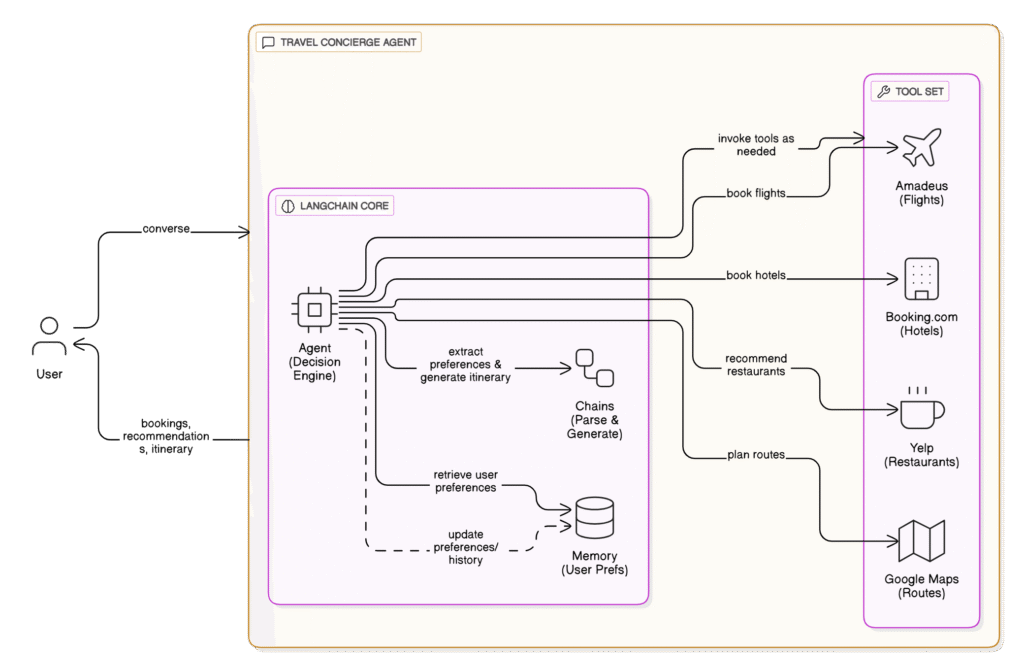The travel industry is being reimagined with AI at its core. Travelers expect seamless, personalized experiences that cater to their unique preferences — from destination recommendations to itinerary management and real-time booking. A conversational agent that plans and books personalized trips is a perfect showcase of this shift.
In this blog post, we’ll explore how to build such a solution using LangChain, one of the most powerful frameworks for orchestrating generative and agentic AI workflows.
Why Use LangChain for Travel Planning Agents?
While large language models (LLMs) like GPT-4 are excellent at understanding natural language and generating responses, they need orchestration to handle real-world workflows. This includes calling APIs, remembering user preferences, handling multi-step reasoning, and managing state across interactions.
LangChain provides the building blocks:
- Chains for sequential workflows.
- Agents for autonomous decision-making.
- Memory for maintaining user context.
- Tools for integrating external APIs like flight search, hotel booking, and payment processing.
This makes it the ideal framework for designing a travel assistant that not only chats but acts intelligently.
Example User Journey
Imagine this interaction:
User: “Plan a 5-day family trip to Italy next month, preferably somewhere warm and historic. My budget is $3,000.”
Agent: “Excellent choice! Would you prefer Rome, Florence, or a mix? Should I include child-friendly activities?”
User: “A mix sounds great. Yes, include child-friendly suggestions.”
Agent: “Perfect! I’ll draft an itinerary with flights, hotels, activities, and dining recommendations. Give me a moment.”
Behind this smooth conversation is a multi-agent system orchestrated via LangChain.
Architecture Overview
LangChain Components in Action
| Component | Role |
|---|---|
| 🔗 Chains | Define linear workflows (e.g., gather preferences → suggest itinerary → book). |
| 🤖 Agents | Autonomous modules for specialized tasks (e.g., destination recommendation, API calls, booking). |
| 📝 Memory | Persist context such as traveler history, budget, past trips, and preferences. |
| 🧰 Tools | External APIs (e.g., Amadeus API for flights, Booking.com API for hotels, Stripe for payments). |
Example LangChain Workflow
Workflow Steps:
Intent Recognition: Classify user intent — planning trip.
Preference Gathering: Conversational follow-up using LangChain’s memory module to capture details:
- Destination type (beach, culture, adventure)
- Budget
- Duration
- Number of travelers
Destination Recommendation Agent: Suggests destinations based on user preferences and weather seasonality (integrates with weather APIs if needed).
Itinerary Generator Chain:
- Searches flights (via Amadeus API)
- Fetches hotel availability (via Booking API)
- Retrieves local attractions (via GetYourGuide API)
Personalization Layer: Tailors suggestions for family-friendly locations, reviews ratings, etc.
Booking Executor Agent: Confirms selections, handles secure payment via Stripe API.
Notification Agent: Sends itinerary and confirmations via email, WhatsApp, or calendar integration.
External APIs and Services to Integrate:
- Flights: Skyscanner, Amadeus APIs
- Hotels: Booking.com, Expedia APIs
- Experiences: GetYourGuide, Viator APIs
- Payment: Stripe, Razorpay
- Calendars: Google Calendar API
- Messaging: Twilio (SMS, WhatsApp) for itinerary notifications.

